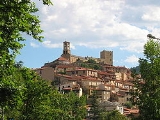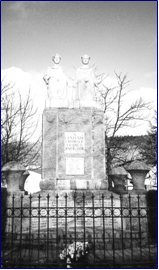
Vernet-les-Bains
Encyclopedia
Vernet-les-Bains is a commune
in the Pyrénées-Orientales
department in southern France
.
It is a centre for visitors and holidaymakers. The village enjoys a sunny climate (with, on average, 300 days of sunshine each year) and is set in a sheltered valley in the foothills of the Canigou
mountain - which rises to a height of 2,785 metres (over 9,000 feet). Tranquil and restful, Vernet-les-Bains has long been known for its hot water spring. There is a professional spa/therapy centre in the village.
The abbey of Saint-Martin-du-Canigou is located at the top of the nearby Canigou
.
which runs 63 kilometres (39.1 mi) from Villefranche-de-Conflent
up to Mont-Louis
and Latour de Carol. The line has the highest station in France at 1593 metres (5,226.4 ft) and is both a vital lifeline during winter conditions and a favourite tourist attraction.
Villefranche-de-Conflent is also on a regional train line that connects to Perpignan
.
While he was in Vernet, Kipling wrote about Canigou. In a letter to the Club Alpin, he praised it as "a magician among mountains".
Kipling also wrote a light-hearted short story entitled Why Snow Falls at Vernet. It makes fun of the English habit of always talking about the weather. This story (in its original English version, and in a French translation) can be seen on this link:
http://docs.google.com/Doc?docid=dfz9vmfp_115c2h3rn&hl=en_GB
Today, the central bridge over the River Cady in Vernet-les-Bains is named after Kipling.
A short walk around the part of Vernet that was best known to Kipling can be seen on this link:
http://perso.orange.fr/alan.mattingly/kiplingbelleepoquewalk.pdf
 Near the highest point in Vernet-les-Bains, next to the mairie (town hall), stands a monument to the Entente Cordiale of 1904. It is the only one of its kind in France.
Near the highest point in Vernet-les-Bains, next to the mairie (town hall), stands a monument to the Entente Cordiale of 1904. It is the only one of its kind in France.
The pedestal of the monument is made of Canigou granite. On it rest two white marble statues representing France and Britain. The pedestal itself is set upon a circular base. That in turn is located on a raised, level area of ground which covers 1,000 square metres and which is bounded by low stone walls.
The idea of erecting this monument was conceived around 1912 by the town council and its then mayor, Monsieur Joseph Mercader. The wealthy British visitors who regularly came to this health spa at that time actively supported the project. A committee of prominent French and British patrons was set up to promote the scheme. Its leading members were Lord Roberts and General Joffre. Monsieur Lambert-Violet, a leading Perpignan businessman, gave the land for the memorial to Vernet. The monument itself was the work of the Roussillon sculptor Gustave Violet, who displayed a model of his proposed work in 1913. However, progress came to a halt in 1914 with the outbreak of World War One. Little further happened until August 1920, when it was proclaimed by presidential decree that work on the monument would proceed but that it would be dedicated both to the Entente Cordiale and to the memory of those killed during the war. At the same time a new appeal was launched for funds to complete the project.
Work on erecting the monument soon got underway. Granite was hauled up from the bed of the River St-Vincent in carts pulled by oxen. The stonemason, Monsieur Herbetta, worked up to fourteen hours a day, often in the sun's full glare, fashioning and putting into place the enormously heavy blocks of stone. A circle of wrought-iron fencing was erected around the base of the monument. Monsieur Antoine Mercader remembers, as a six-year-old child, how he and other children watched with amazement as the craftsman, Monsieur Serra, poured molten lead into small holes in the ground to seal in place the fence's iron bars.
When the monument was completed, it bore the following dedications:
"To the Entente Cordiale between France and Britain. To the glory of the Allied Nations. To the memory of soldiers from Vernet who died for their country"
Communes of France
The commune is the lowest level of administrative division in the French Republic. French communes are roughly equivalent to incorporated municipalities or villages in the United States or Gemeinden in Germany...
in the Pyrénées-Orientales
Pyrénées-Orientales
Pyrénées-Orientales is a department of southern France adjacent to the northern Spanish frontier and the Mediterranean Sea. It also surrounds the tiny Spanish enclave of Llívia, and thus has two distinct borders with Spain.- History :...
department in southern France
France
The French Republic , The French Republic , The French Republic , (commonly known as France , is a unitary semi-presidential republic in Western Europe with several overseas territories and islands located on other continents and in the Indian, Pacific, and Atlantic oceans. Metropolitan France...
.
It is a centre for visitors and holidaymakers. The village enjoys a sunny climate (with, on average, 300 days of sunshine each year) and is set in a sheltered valley in the foothills of the Canigou
Canigou
The Canigou is a mountain located in the Catalan Pyrenees of southern France.Due to its sharp flanks and its dramatic location close to the coast, until the 18th century the Canigou was believed to be the highest mountain in the Pyrenees.-Trekking and sightseeing:Spectacular jeep tracks on the...
mountain - which rises to a height of 2,785 metres (over 9,000 feet). Tranquil and restful, Vernet-les-Bains has long been known for its hot water spring. There is a professional spa/therapy centre in the village.
The abbey of Saint-Martin-du-Canigou is located at the top of the nearby Canigou
Canigou
The Canigou is a mountain located in the Catalan Pyrenees of southern France.Due to its sharp flanks and its dramatic location close to the coast, until the 18th century the Canigou was believed to be the highest mountain in the Pyrenees.-Trekking and sightseeing:Spectacular jeep tracks on the...
.
Transportation
Close by is the Yellow trainYellow train
The Ligne de Cerdagne, often called the Yellow Train , is a metre gauge railway that runs from Villefranche-de-Conflent through to Mont-Louis in France. It was started in 1903 and the section to Mont-Louis was completed in 1910, followed by an extension to Latour-de-Carol in 1927.It is long and...
which runs 63 kilometres (39.1 mi) from Villefranche-de-Conflent
Villefranche-de-Conflent
Villefranche-de-Conflent is a commune in the Pyrénées-Orientales department in south of France.-The Capital of Conflent:The original town dates from 1098 and is fortified because of its strategic position in lands that changed hands between French and Spanish occupation.* 1374, Villefranche...
up to Mont-Louis
Mont-Louis
Mont-Louis is a commune in the Pyrénées-Orientales department in southern France.In 2008, the citadel and the city walls of Mont-Louis were listed as a UNESCO World Heritage Sites, as part of the "Fortifications of Vauban" group....
and Latour de Carol. The line has the highest station in France at 1593 metres (5,226.4 ft) and is both a vital lifeline during winter conditions and a favourite tourist attraction.
Villefranche-de-Conflent is also on a regional train line that connects to Perpignan
Perpignan
-Sport:Perpignan is a rugby stronghold: their rugby union side, USA Perpignan, is a regular competitor in the Heineken Cup and seven times champion of the Top 14 , while their rugby league side plays in the engage Super League under the name Catalans Dragons.-Culture:Since 2004, every year in the...
.
Walks near Vernet-les-Bains
There are many beautiful walks from and close to Vernet-les-Bains. In particular it is an ideal base from which to climb to the summit of Canigou.Rudyard Kipling in Vernet-les-Bains
Rudyard Kipling, who was awarded the Nobel Prize for literature in 1907, stayed in Vernet-les-Bains in 1910, 1911 and 1914. At that time, Kipling was well known in France, following the success of the French version of his classic work, The Jungle Book.While he was in Vernet, Kipling wrote about Canigou. In a letter to the Club Alpin, he praised it as "a magician among mountains".
Kipling also wrote a light-hearted short story entitled Why Snow Falls at Vernet. It makes fun of the English habit of always talking about the weather. This story (in its original English version, and in a French translation) can be seen on this link:
http://docs.google.com/Doc?docid=dfz9vmfp_115c2h3rn&hl=en_GB
Today, the central bridge over the River Cady in Vernet-les-Bains is named after Kipling.
A short walk around the part of Vernet that was best known to Kipling can be seen on this link:
http://perso.orange.fr/alan.mattingly/kiplingbelleepoquewalk.pdf
The Entente Cordiale Monument in Vernet-les-Bains

The pedestal of the monument is made of Canigou granite. On it rest two white marble statues representing France and Britain. The pedestal itself is set upon a circular base. That in turn is located on a raised, level area of ground which covers 1,000 square metres and which is bounded by low stone walls.
The idea of erecting this monument was conceived around 1912 by the town council and its then mayor, Monsieur Joseph Mercader. The wealthy British visitors who regularly came to this health spa at that time actively supported the project. A committee of prominent French and British patrons was set up to promote the scheme. Its leading members were Lord Roberts and General Joffre. Monsieur Lambert-Violet, a leading Perpignan businessman, gave the land for the memorial to Vernet. The monument itself was the work of the Roussillon sculptor Gustave Violet, who displayed a model of his proposed work in 1913. However, progress came to a halt in 1914 with the outbreak of World War One. Little further happened until August 1920, when it was proclaimed by presidential decree that work on the monument would proceed but that it would be dedicated both to the Entente Cordiale and to the memory of those killed during the war. At the same time a new appeal was launched for funds to complete the project.
Work on erecting the monument soon got underway. Granite was hauled up from the bed of the River St-Vincent in carts pulled by oxen. The stonemason, Monsieur Herbetta, worked up to fourteen hours a day, often in the sun's full glare, fashioning and putting into place the enormously heavy blocks of stone. A circle of wrought-iron fencing was erected around the base of the monument. Monsieur Antoine Mercader remembers, as a six-year-old child, how he and other children watched with amazement as the craftsman, Monsieur Serra, poured molten lead into small holes in the ground to seal in place the fence's iron bars.
When the monument was completed, it bore the following dedications:
"To the Entente Cordiale between France and Britain. To the glory of the Allied Nations. To the memory of soldiers from Vernet who died for their country"
External links
- Vernet les Bains official website
- http://perso.orange.fr/alan.mattingly/cadyguide.pdf Walks around Vernet-les-Bains, and to the summit of Canigou
- http://perso.orange.fr/alan.mattingly/monjoswalk1999translation.pdf A walk to St-Martin-du-Canigou
- More walks around Vernet-les-Bains, plus information about the landscape and history of the area
- http://perso.orange.fr/alan.mattingly/vernetpywalk.doc A day walk from Vernet-les-Bains to the village of Py

